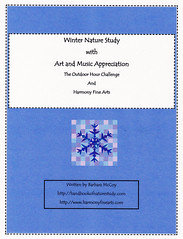 Outdoor Hour Challenge
Outdoor Hour Challenge Winter Series #9
Mammals in Winter
Many mammals are nocturnal and you will rarely spot them to observe up close. Some mammals hibernate in the winter and they are not easily observed either. Many more mammals are just plain shy and rarely show their faces. Reading about them and learning their behaviors will help you find and observe them in the wild if you are diligent...it may not be this week or this year but you will be ready if you do the study ahead of time.
Any study of mammals can be done with what you have on hand. Do you have a pet dog, cat, mouse, or rat? Do you have a relative or neighbor that has a dog or cat they will let you observe? How about visiting a pet store? Be creative. If you would like additional information on what a mammal is so you can share with your children, here is a link to a general definition as well as links to various mammals and their photos.
Mammals
For this challenge, you can use the Handbook of Nature Study to pick a mammal to study this winter or you can use the Discover Nature in Winter book to read about mammals and then use the information there to look for animal tracks during your outdoor time. Either way will give your family a great study of a mammal.
Inside Preparation Work
If you are using the Discover Nature in Winter book:
Read chapter nine in Discover Nature in Winter. Mammals in general tend to be shy of humans. In the winter, it is even more difficult to observe mammals. The chapter suggests looking for signs of mammals instead like tracks and scat. Highlight ideas for your family to try this week while you are outdoors and looking for mammals.

Our family is going to review the chart showing different animal tracks on page 182 and 183. We might try sketching some of the tracks into our nature journal as a reference for future outdoor time. In our area, we often come across animal scat as we hike and we are going to familiarize ourselves with the various kinds of scat by studying the illustrations in this chapter.
Without the Discover Nature in Winter book:
You can still look up some animal tracks online using this link:
Animal Tracks at Beartracker
Outdoor Hour Time
This week the challenge is to get outdoors and look for signs of animals. You can look for tracks, scat, holes, scratches, hair, or other things that mammals leave behind. Remember to make your nature study time like an investigation.
Follow-Up Activity:
1. Keep a record of animal tracks you have observed in the snow or mud. Record your findings in your nature journal along with a drawing, the date, the weather, the time of day, and the type of animal if you have identified it at this time. You can use the Winter Series notebook page, pages from the sidebar of the Handbook of Nature Study blog, or your own blank journal.
2. Compare a dog’s and a cat’s footprints in the snow or mud.
3. Research an animal that hibernates and record what you learn in your nature notebook. You can also sketch your animal and what its tracks look like.

If you would like all the Winter Series Challenges in one book, I have an ebook gathered for you to purchase for your convenience. The ebook also contains art and music appreciation plans for the winter months as well. Please see this entry for more details:
Winter Nature Study Ebook Now for Sale. You can also purchase just a set of custom notebook page for the Winter Series Challenges by following the link above.
Make sure to come back and enter your blog entry for this challenge in Mr. Linky.
Barb-Harmony Art Mom
